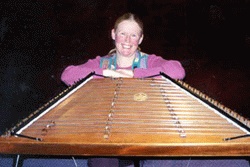Even when Denise and Amanda agree on the same tune they don't always play it exactly the same. "The Cherry Tree" is the next tune we all take a go at. That starts another musical discussion. Like most every tune we do it creates an interesting musical dialogue where words are replaced by notes, rhythms, chords, harmonies and body language. Every performance is unique. It is very Socratic -- it's a dialogue, the questions change and so do the responses. The tunes are never the same when played like this. If you play music as it is written it is always the same. The subtlety of our music would have to be written different every time we played a tune only to never be played that way again.
Socrates didn't believe in writing. He believed that once words were written they stayed the same. You could ask them questions and they would always give you the same answers. So it is with this music. When we don't play with written music we are free to have an impromptu musical conversation. And when we have different musical opinions we are forced into musical debate. Maybe that's one of the reasons why they started writing music down. Debate is okay, but it can get old after a while. Yet today we have a refreshing debate.
 |
| Denise Martin and her hammered dulcimer |
 |
To resolve the musical debate over melody, Amanda and Denise take turns leading the tune. A good tune has a beginning, middle and an end. The melody serves as the basic plot line. The twists in this plot are changes in tempo, volume, ornamental additions and outright departures from the melody.
The beginning of a tune is usually an exclamation. In the middle the dialogue with phrases tell a story without words -- a story that can be different for every listener; a story that can be different every time a listener hears it; a story that can be different every time a player plays it; but at the end of the tune we all try to say something together and come to closure.
Sometimes Amanda tells the story with her fiddle. Other times Denise tells the story. I always provide the background to the story with my guitar chords and rhythms. Denise and Amanda occasionally take a turn at the background with harmony and sometimes chords and syncopated rhythms. The interesting part is when the melody instruments take turns and the music becomes a dialogue amongst the instrumentalists. The jazz players create some of the most amazing dialogue I have ever heard. Irish musicians are on the other end of the extreme; they all play the melody in unison. Not much dialogue there.




